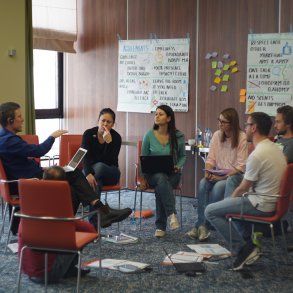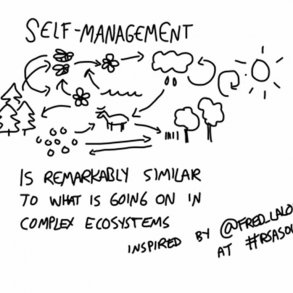By Jane Pightling and originally published on LinkedIn
This is Part 1 of a 3-part series. EE Magazine has republished Part 2 here and Part 3 here.
Some new organisations are set up with the intention of being self-organising but for many the challenge is a different one. The way an organisation that exists within a traditional management and hierarchical structure can reinvent itself is a focus of Laloux’s current work.
This is the reality of most organisations in health and social care. How can it be possible to take a traditional health and social care organisation and move it towards being a self-organising entity? As the Reinventing Organisations movement emerged four years ago, I remember conversations with leaders of new self-managing organisations in the private sector who told me it was quite impossible. They were wrong.
Self-management is the aspect of this new way of working most focused on. The reports of significant savings in the costs of corporate functions, coupled with the ability to re-engage staff through autonomy and improving the quality of services provided, are very attractive. In the health and care world, which traditionally values doing, there is a temptation to focus on re-organising and how we “do” self-management.
Ignoring the other elements that make this approach successful, the culture we create, our purpose, the values and beliefs we hold and how it feels to work or receive services are a vital part of this approach and must demand our equal attention.
There are various possibilities when considering a transition to this way of working.
Some organisations create teams to pilot this method, working as part of but distinct from the larger organisation.
To protect this new way of working many projects build a firewall between the pilots and the existing organisation.
All communications and interactions are channelled to the new team via a small group of staff and the workload and resources of the team are protected from processes that are used in the wider organisation. It is not yet clear if this approach can successfully transition the host organisations to a new way of working. Indeed, in several organisations hosting these pilots, it is not clear that the organisation itself intends to make this move.
There are examples in private industry, perhaps Zappos being the most famous, where leadership has taken the decision to move the whole organisation in this direction and issued an ultimatum. For health and care organisations, who need to ensure safe continuous service, this is not a practical option. Customers may be inconvenienced by lack of new shoes but people and communities would suffer if health and care services are badly disrupted.
This adds a whole new dimension to the challenge of change. There are several examples where action by staff groups and communities have halted or seriously disrupted change initiatives in health and care and organisations. Organisations making this move need to be mindful but not paralysed by this awareness.
An alternative approach is to work with a whole organisation and support it to evolve in this direction.
Some organisations may dismiss this as too complex, too risky and too slow. Indeed, it is not a journey that should be embarked upon without significant consideration, energy and courage.
Perhaps because of this, I believe this approach is more likely to deliver successful and sustainable results. When working in the field there is often a request to supply a route map or a project plan to “roll-out” the approach. People want a set of instructions, that if followed will get the organisation to where it wants to be. Herein lies another challenge. This methodology is founded on the belief that rigid long-term plans are not helpful in the VUCA world our health and care organisations inhabit. Every organisation must be alive to its purpose and constantly responding to the needs of the people and communities it serves.
The route followed by one organisation, or even a service area in a large health and care organisation, will be different from another. It needs to be, or the organisation will not be taking full advantage of the intelligence, talent and passion of its frontline and the communities it works with. There is no one route map and organisations should beware of anyone that tells them there is.
On the other hand, there is a growing and generous community of health and care organisations who already work in this way. They generate learning and advice that can be taken and built upon. From this we can identify some useful foundation stones on which we can base our work. (Read more about these in part 2). We can use this learning intelligently and intentionally to evolve an organisation.
Using methods that align with the self-management approach is important in achieving the cultural shift needed for the work.
Used skilfully it can provide the pace and assurance of usual project infrastructure and will provide more successful and sustainable results. When we step back, this method is not so different from the work being done to create Integrated Care Organisations. There is no blueprint for this either but a commitment to move in this direction, courage and a willingness to learn together is driving this forward.
The content of the work and way the principles are woven together in the new way of working may be new, but health and care has been evolving new approaches, breaking new ground and achieving the impossible for decades. It’s time to rediscover those abilities.
Republished with permission.
Featured Image/graphic link and block quoting added by Enlivening Edge Magazine.




